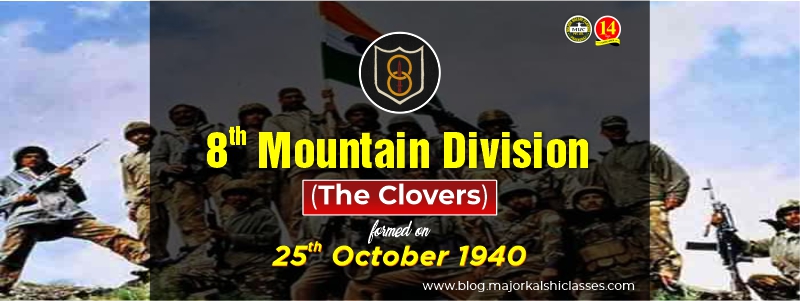8th MOUNTAIN DIVISION-THE CLOVERS
In this blog I shall be talking about the 8th Indian Infantry Division or the 8th Mountain Division. This division is popularly known as –“THE CLOVERS”.
The 8th Mountain Division was raised as the 8th Indian Infantry Division of the British Indian Army. At present it is a part of the Indian Army and specializes in mountain warfare.

The clovers (8th Infantry Division) was formed in Meerut on 25th of October in the year 1940. It was formed under Major General Charles Harvey, a British Indian Army Officer, as a part of the Indian Army during the Second World War.
At first it served in the Middle East in the garrisoning of Iraq. Later on invaded Persia in order to secure the oil fields of the area for the Allies.
The division was disbanded at the end of the Second World War in the year 1946. It was re-formed again in 1963 as specialist Mountain Division of the Indian Army.
RE RAISING
The division was re-raised on 01 August 1963 at Ranchi with Major General KP Candeth as the first General Officer Commanding (GOC). The division differs from more conventional infantry divisions in the emphasis that is placed on infantry tactics and the limited role that armour can be expected to take in operations in mountainous terrain. The armour that is used may differ from that used by other infantry divisions, for example, specialised mountain guns are required in many areas where the division might be expected to operate.
The division has been constantly involved in operations since its creation, earning the sobriquet Forever in Operations Division. It was initially created for operations against insurgents fighting for a separate state of Nagaland and headquartered at Zakhama (near Kohima). As part of Operation Orchid, it was deployed in the hills of Nagaland, Manipur, Mizoram and Arunachal Pradesh for counter insurgency operations.
RE LOCATION
The formation was moved to the state of Jammu and Kashmir in March 1990 in response to conflict there. It was concentrated in the Kashmir valley and tasked for counter insurgency operations. It was put under the Northern Command and also served as its reserve division.[16] In addition to counter insurgency operations (Operation Rakshak), the division helped in the conduct of the 1996 parliamentary elections in Srinagar and Baramulla districts. Prior to the Kargil War, the division had the following brigades[17]–
- 56 Mountain Brigade at Wusan in Ganderbal district
- 192 Mountain Brigade in the northern parts of the valley, including Sopore
- 81 Mountain Brigade
- 8 Mountain Artillery Brigade in Tangmarg
- 11 Sector Rashtriya Rifles in southern Kashmir

For more blogs articles and daily current affairs subscribe to blog.majorkalshiclasses.com








